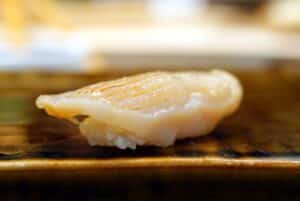Awabi Sushi (Abalone Profile)
What is Awabe (Abalone)?

The flesh that is eaten is entirely muscle meat, which results in an extremely firm texture. It is is actually the foot muscle, which allows the abalone to propel itself (slowly) in the wild. In Japanese culture, awabe is consumed raw, steamed, salted, boiled, or simmered in soya sauce. When used for sushi, the ingredient is either raw or even live.
The taste of awabi is delicate and subtle, and as such is best served without accompaniment. The slightly rubbery texture of the ingredient lends to raw consumption, making it a perfect sushi item. Cooking abalone will only increase the toughness of the already firm meat.
Due to its tough texture, awabi, particularly when served as sashimi, will often be separated from its shell and cut very thinly, against the grain of the meat. Because of the firmness of the meat, awabi can be lightly scored to increase tenderness. True lovers of abalone will eat the delicacy as it is, or coat it lightly with soy sauce. Live abalone for sushi is of the highest grade, called Ezo Awabi, and commands a respectable price tag.
There is a huge demand for abalone, and not just for the meat. The shells are used in jewelry, as they are iridescent and beautiful to behold. When the supply of legally fished abalone exceed demand, it creates an environment for poaching and illegal fishing. Unfortunately, they are prone to poaching because of the fact that they grow in pond sized patches and remain there for their entire lives. This makes them easy pickings for both overfishing and unscrupulous poachers. Unregulated and unsustainable fishing has lead to a decline in wild stocks world-wild. In addition, they are delicate creatures and the acidification of the world’s oceans is leading to erosion of their shells. This makes them fragile and prone to die-offs, so the future of this delicacy is truly in question.
Abalone is a high priced delicacy, which makes it all the more susceptible to greedy poachers. This has lead to countries creating stringent regulations in the fishing and trade of abalone, which has lead to an increase in farmed abalone to meet demand. Some of the largest producers of cultured abalone are the countries of South Africa, Taiwan, Chile, Iceland, and Mexico. There are barriers to the farming of abalone, however, including the slow rate of growth of the species as it can take more than 3 years for one to be ready for the market.
Abalone is hugely popular in China and especially Japan, but has not seen a huge popularity in the western world in sushi. This may be the best for the future of the species, as sustainable farming and cultivation methods are just now becoming more efficient and possible as the kinks in the process are worked out.
